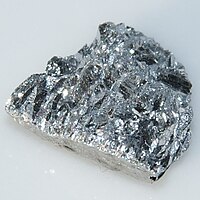
Photo from wikipedia
Recently, Fe-doped semiconductors have been attracting much attention as ferromagnetic semiconductors due to the possibility that they may exhibit high Curie temperatures and low power consumption and that they may… Click to show full abstract
Recently, Fe-doped semiconductors have been attracting much attention as ferromagnetic semiconductors due to the possibility that they may exhibit high Curie temperatures and low power consumption and that they may be useful for high-speed spin devices. High Curie temperature ferromagnetism has been observed in Fe-doped InAs, from which both n- and p-type ferromagnetic semiconductors can be fabricated. In order to obtain a higher Curie temperature than that of (In, Fe)As, we have focused on GaSb and InSb as host semiconductors. We have investigated their electronic structures, magnetic properties, and structural stability by using the Korringa-Kohn-Rostoker Green's function method within density functional theory. We have found that (Ga, Fe)Sb and (In, Fe)Sb show complex magnetic properties, which are determined by the correlation between magnetic exchange coupling constants and chemical pair interactions. Isoelectronic Fe-doped GaSb and InSb have strong antiferromagnetic interactions due to the super-exchange mechanism. By shifting the Fermi level–i.e., by n- or p-type doping–(Ga, Fe)Sb and (In, Fe)Sb can be made to undergo a magnetic transition from antiferromagnetic to ferromagnetic ordering. This transition can be well understood in terms of the Alexander-Anderson-Moriya mechanism. Our calculations indicate the possibility of manipulating (Ga, Fe)Sb and (In, Fe)Sb to achieve high Curie temperatures.Recently, Fe-doped semiconductors have been attracting much attention as ferromagnetic semiconductors due to the possibility that they may exhibit high Curie temperatures and low power consumption and that they may be useful for high-speed spin devices. High Curie temperature ferromagnetism has been observed in Fe-doped InAs, from which both n- and p-type ferromagnetic semiconductors can be fabricated. In order to obtain a higher Curie temperature than that of (In, Fe)As, we have focused on GaSb and InSb as host semiconductors. We have investigated their electronic structures, magnetic properties, and structural stability by using the Korringa-Kohn-Rostoker Green's function method within density functional theory. We have found that (Ga, Fe)Sb and (In, Fe)Sb show complex magnetic properties, which are determined by the correlation between magnetic exchange coupling constants and chemical pair interactions. Isoelectronic Fe-doped GaSb and InSb have strong antiferromagnetic interactions due to the super-exc...
Journal Title: Journal of Applied Physics
Year Published: 2018
Link to full text (if available)
Share on Social Media: Sign Up to like & get
recommendations!